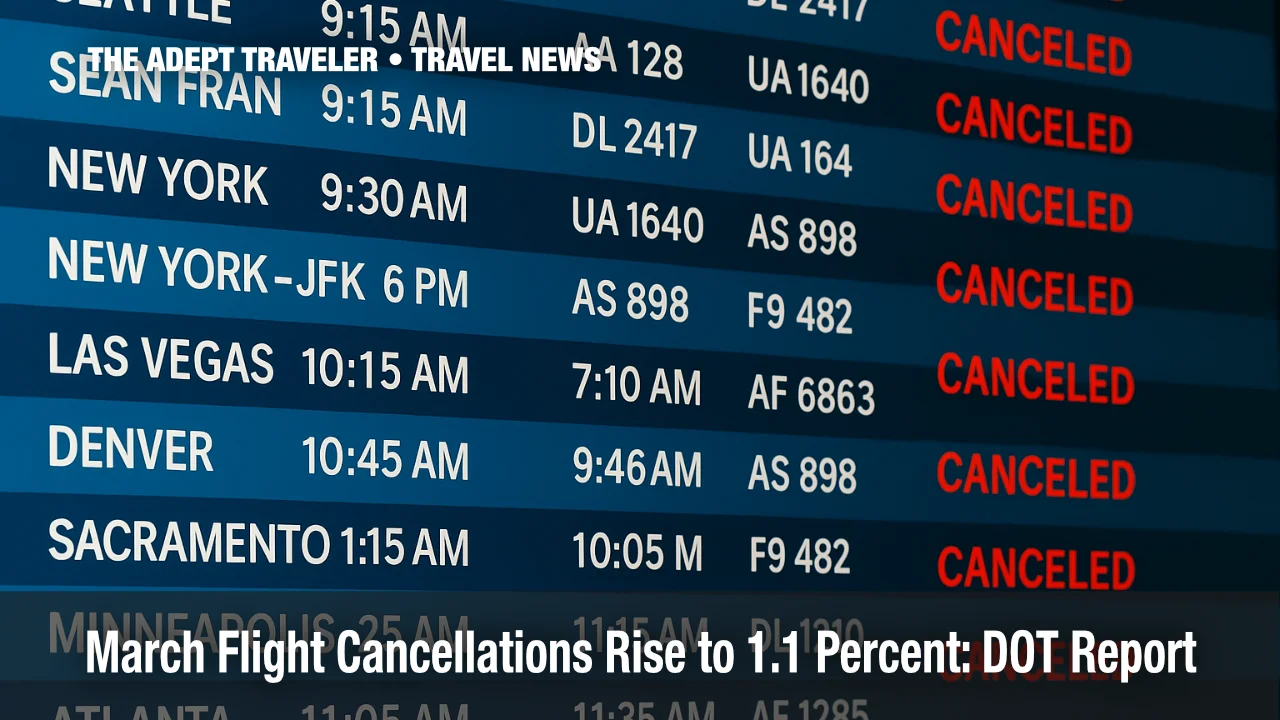March Flight Cancellations Rise to 1.1 Percent: DOT Report

Flight cancellations-every traveler's dread-ticked up again in March 2025. The U.S. Department of Transportation's newly released Air Travel Consumer Report pegs the month's nationwide flight cancellations at 1.1 percent of scheduled domestic departures, up from 0.9 percent in March 2024. Although the increase is modest, it translates to more than 2 200 additional scrapped flights and underscores why first-quarter storm season and carrier staffing gaps still matter to trip planners.
Key Points
- Why it matters: Nearly 7 600 domestic flights were canceled in March, disrupting about one in every 90 itineraries.
- Total scheduled flights: 664 932; canceled: 7 581 (1.1 %).
- March 2024 baseline: 5 377 cancellations out of 628 786 flights (0.9 %).
- American Airlines Network posted the highest rate (2.1 %); Delta and Allegiant shared the lowest (0.6 %).
- Severe weather in the Southeast and Midwest drove many same-day cancellations.
Flight Cancellations Snapshot - How It Works
DOT's monthly Air Travel Consumer Report aggregates data from 14 marketing carriers that each hold at least 0.5 percent of U.S. passenger revenue. A cancellation occurs when a scheduled flight is scrubbed after being loaded into an airline's reservations system. The bureau tracks both network (mainline + regional) and mainline-only results, letting flyers compare overall reliability and the performance of partner feeders that might operate their short-haul segments. Unlike private delay trackers, the DOT database is mandatory and audited, making it the industry's most authoritative scorecard for airline on-time performance and cancellation rates.
Flight Cancellations Background - Why It Matters
Cancellations spiked during the pandemic (cumulative 5 percent in 2020) and again amid the 2022 pilot shortage. DOT pressure led carriers to staff up and trim ambitious schedules, pushing the 2023 full-year rate down to 1.3 percent. March has historically been volatile: winter's tail-end storms collide with spring-break demand, and congestion at hub airports magnifies ripple effects. For March 2019-pre-COVID-the cancellation rate stood at 2.0 percent; by March 2023 it had fallen to 1.3 percent. This year's 1.1 percent still beats that longer-term average, yet the uptick from 2024 shows how quickly performance can backslide.
Flight Cancellations Latest Developments
A mild winter quickly turned stormy in early March 2025, hammering hubs from Charlotte to Dallas and triggering travel waivers at the Big Three airlines. The DOT report captures the fallout:
Network Winners and Laggards
Top performers:
Delta Air Lines Network - 0.6 % (416 mainline cancellations plus 437 by regional partners).
Allegiant Air - 0.6 % on a leisure-oriented schedule less exposed to congested hubs.
Middle tier (≈0.8 %): Alaska, United, JetBlue, and Southwest kept cancellations below one percent despite scattered staffing constraints. United's mainline figure was an industry-leading 0.3 percent, though regionals dragged the network average up.
Underperformers:
Spirit Airlines - 1.1 %.
Hawaiian Airlines - 1.7 %, hit by island thunderstorms that limited runway capacity at Honolulu.
Frontier Airlines - 2.0 %.
American Airlines Network - 2.1 %, with regional affiliates canceling 2.6 percent of flights as storms snarled Dallas/Fort Worth and Charlotte.
Weather-Driven Hotspots
Regional tornado outbreaks on March 5 and 13-16 forced ground stops across Texas, the Carolinas, and the Midwest, accounting for roughly one-third of the month's cancellations. Charlotte Douglas International alone logged nearly 200 scrubbed departures on March 5, briefly ranking as the world's most-affected airport. Late-month wind events at DFW and ORD added pressure just as Easter travel peaked.
On-Time Performance Still Improved
Paradoxically, the same report shows overall airline on-time performance rising to 79.4 percent in March 2025, up from 77 percent a year earlier. When flights did operate, they reached the gate within 15 minutes of schedule more often than last spring-evidence that pared-down timetables and better crew scheduling helped carriers stay punctual outside weather flashpoints.
Analysis
For travelers, a 0.2-point jump in cancellations may feel minor-until your aircraft goes tech or your connecting crew times out. Domestic itineraries now face roughly a one-in-90 chance of being canceled, versus one-in-110 a year ago. Booking nonstop routes, early-morning departures, and flights on historically reliable carriers such as Delta or Alaska still cuts risk. Those who must change planes through storm-prone hubs should leave at least a two-hour buffer or build in an overnight. Travel advisors can reinforce protection by coupling refundable fares with robust insurance policies that cover trip interruption.
Business travelers in particular should watch American's regional network; a 2-plus-percent cancellation rate on feeder flights means a higher probability of missed corporate meetings. Leisure flyers using ultra-low-cost carriers face fewer cancellations than in 2022, but Frontier's 2.0 percent underscores why paying for flexible rebooking may be prudent on peak-season dates. Meanwhile, DOT's forthcoming automatic cash-refund rule-slated to take effect later this year-will make it easier to recoup sunk costs when flights disappear. Our DOT air travel report dashboard keeps tabs on the rule's timeline; bookmark our airline fee guide for updates.
Final Thoughts
March's uptick in flight cancellations is a reminder that weather and regional-carrier fragility can undo even the best-laid plans. Check forecasts a week out, aim for carriers with sub-1 percent cancellation records, and build slack into connections-especially at Dallas, Charlotte, and Chicago in early spring. Finally, save digital copies of receipts and e-tickets; DOT's strengthened refund mandate will soon deliver faster compensation, but only if you can prove what you spent.
